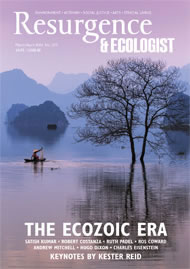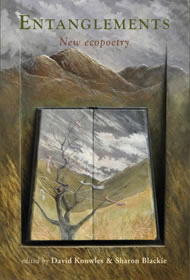There are many delicious poems in this new anthology from an Outer Hebridean press that focuses exclusively on ecoliterature. Entanglements opens with three pieces on the Fraser River by the acclaimed Canadian Catherine Owen. Nature Writing 101 is her Orwellian twist on our relationship with the natural world: “The trees are all gone but then aren’t our hearts | more similar to wastelands… | Our minds can assimilate all horrors. | Is the problem.”
Here the idea is well executed, and in her subsequent pieces, Beseech and They Will Disappear These Ruins & This Beauty Too, her deployment of language continues to evoke the remnants of human industry and Gaian beauty, which is finally juxtaposed with the advertising empire/machine: “the ads singing haven over the barren inhabited lands… | the empty river groomed for them as wallpaper, as screen”.
In their editors’ notes, David Knowles and Sharon Blackie indicate that although their curation process involved endless reordering of their selected material – a stylistically diverse spectrum of contemporary work from Canada, the USA, the UK and Australia – the opening and closing pieces remained the same. The choice to conclude with Alice Oswald’s brilliant epistle was well made. Surveying the property once owned by the captain of a Spanish treasure ship, Sharpham House becomes overrun by the exuberant marginalia-cum-inventory of wild plants, creatures, humans (“Buddhists, historians”), and even detritus that make today’s Sharpham estate flow beyond the page: “life is not so limited in its pen and ink...”
Awareness of this human–Nature continuum is evident in various other poems. Mario Petrucci’s Close in in and When Milk Enters experiment through language and form with his perceptions of his newborn son: “your far-shrilled | gull motions in circles to | whittle stillness then | drop to a pose | abruptly.” Other poems similarly link the body and landscape, such as John Kinsella’s Penillion of Cambridgeshire as My Body and Susan Rowland’s For the Forest: “I found my navel in a crater | Of blue rain.”
There are poems informed by an intimate relationship with the other-than-human – Jane Routh’s The Teachings of Strix Aluco is written from the Tawny Owl’s perspective, while Chris McCully’s Watching White Trout on the River Dargle draws on his observation and hunting of this species. His poem foregrounds the long history of their existence: “While Troy torched laughter onto a girl’s cheeks; | throughout the centuries-long scourging of the Christ; | … |restless, unwitting, they were doing the same, | their shadows nuzzling under the alder.”
I could single out other beautifully conceived and crafted poems, but this would fail to convey an aspect of Entanglements that bothered me. This was the editors’ “growing hunger for a meaningful connection with the earth” having been met by too many poems in which a solitary human walks (or even drives) in a landscape. In an anthology of ecopoetry, I enjoy reading others’ experiences of (inter)connection, and especially savour the expression of ideas and actions inspired by the now multiple and extensive fields of ecological thought (much of which has been featured in Resurgence & Ecologist for over four decades) that one might expect to find shaping the ecopoetic imagination. The editors had deliberately chosen to exclude political poems (despite acknowledging “the achievements of poetry under the oppressive regimes of the USSR and … springing from the Troubles in Ireland”), and I question this decision. I also wonder if some of the material presented as ‘ecopoetry’ should be defined as such.
Can we really say that any piece written about ‘Nature’ in the 21st century is ecopoetic? Or should this term be reserved for a growing pan-global body of work that is genuinely informed by the ancient/new ecological consciousness influencing emergent culture?
Helen Moore’s debut collection, Hedge Fund: And Other Living Margins, is published by Shearsman Books. To read her essay on ecopoetry visit www.internationaltimes.it/what-is-ecopoetry/







